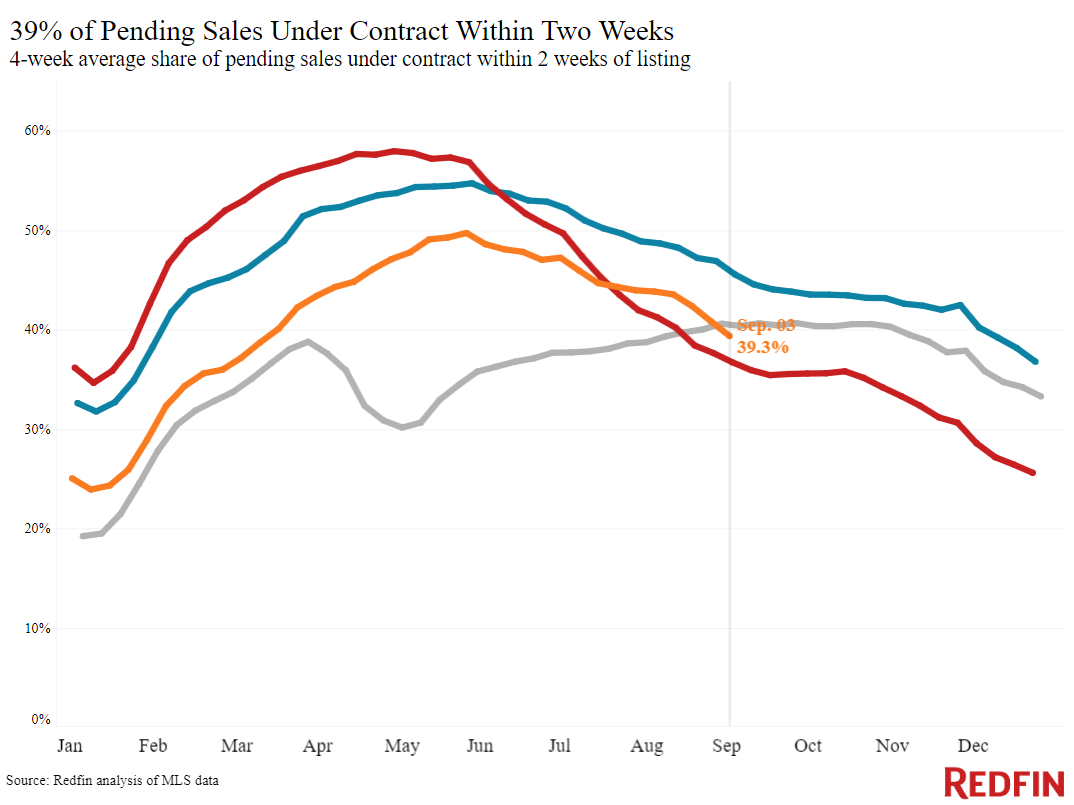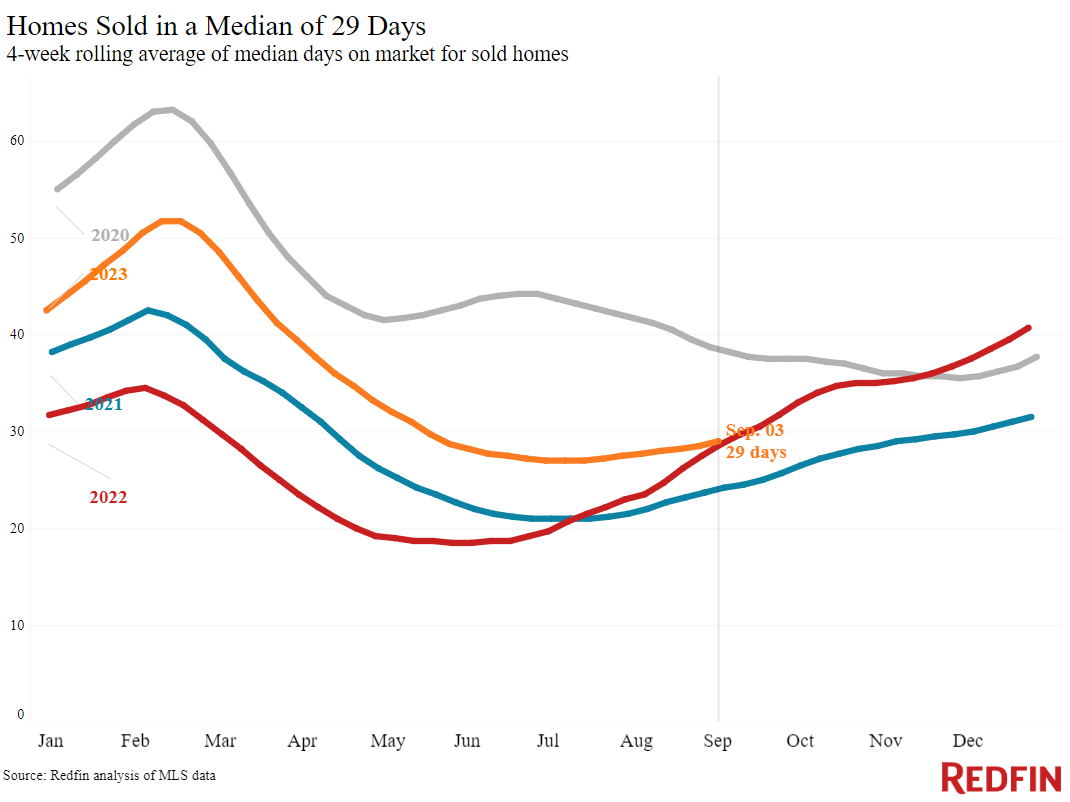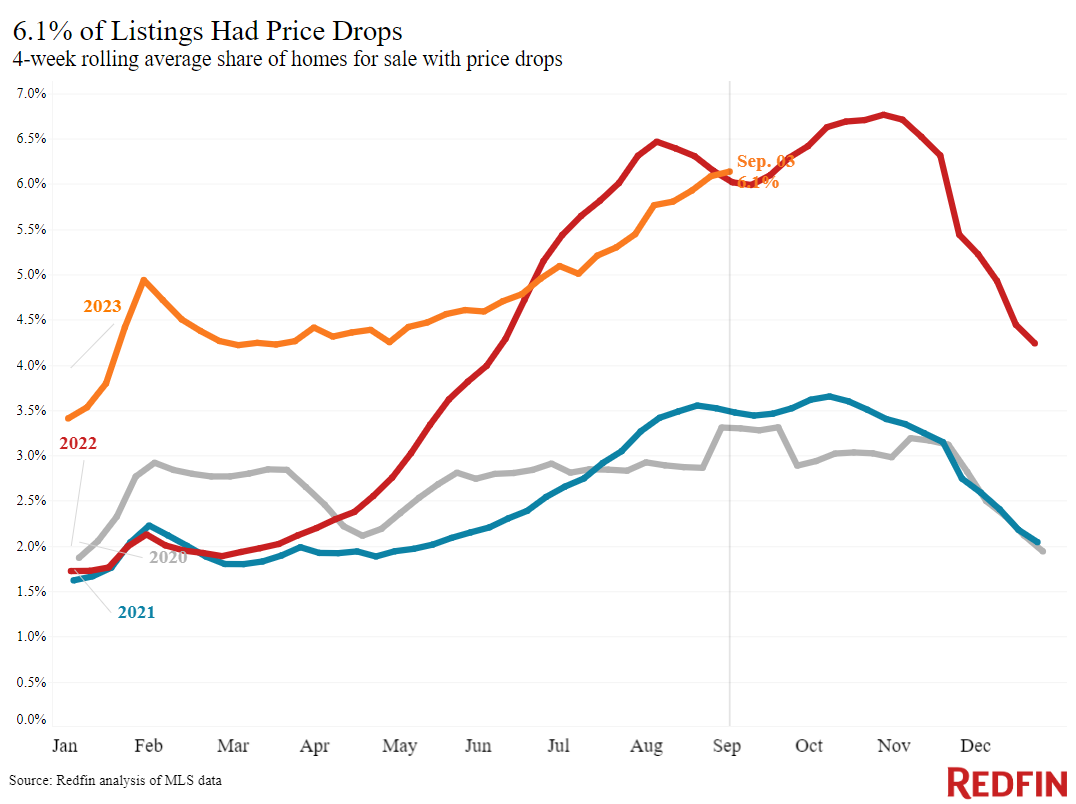Mortgage-purchase applications are sitting at their lowest level in nearly three decades. But there are so few homes for sale that prices are up 4.5% annually, the biggest increase in nearly a year.
Although mortgage rates are inching down from their recent peak, housing affordability isn’t improving much. With the median U.S. home-sale price up 4.5% year over year during the four weeks ending September 3 and mortgage rates remaining above 7%, the typical monthly mortgage payment is $2,612, just $18 shy of the all-time high set in May. High housing costs are dampening homebuying demand, with mortgage-purchase applications falling to a 28-year low.
Prices are rising due to a supply shortage: The total number of homes on the market is down 18% year over year, the biggest decline since February 2022. New listings are down 9% as many homeowners refuse to part with relatively low mortgage rates. But there are still more buyers than sellers in much of the country.
“The market is marching on, especially for turnkey homes,” said Chicago Redfin Premier agent Niko Voutsinas. “If folks can figure out a way to buy instead of rent, they will. Some buyers are cutting back on other expenses to up their housing budgets because they believe home prices are only going to increase. They’re nervous that the minute rates come down, a flood of competition will edge them out. Those buyers typically need to move quickly and offer at or above the asking price if they love a home, because so few listings are hitting the market.”
Leading indicators
| Indicators of homebuying demand and activity | ||||
| Value (if applicable) | Recent change | Year-over-year change | Source | |
| Daily average 30-year fixed mortgage rate | 7.33% (Sept. 6) | Down from a peak of 7.49% two weeks earlier | Up from 6.12% | Mortgage News Daily |
| Weekly average 30-year fixed mortgage rate | 7.18% (week ending August 31) | Down slightly from 7.23% a week earlier | Up from 5.66% | Freddie Mac |
| Mortgage-purchase applications (seasonally adjusted) | Down 2% from a month earlier | Down 28% | Mortgage Bankers Association | |
| Redfin Homebuyer Demand Index (seasonally adjusted) | Down 3% from a month earlier (as of the 4 weeks ending Sept. 3) | Down 6% | Redfin Homebuyer Demand Index, a measure of requests for tours and other homebuying services from Redfin agents | |
| Google searches for “home for sale” | Down 11% from a month earlier (as of Sept. 5) | Down 16% | Google Trends | |
| Home touring activity | Down 16% from the start of the year, same as last year’s decline (as of Sept. 4) | ShowingTime, a home-touring tech company | ||
Key housing-market data
| U.S. highlights: Four weeks ending September 3, 2023
Redfin’s national metrics include data from 400+ U.S. metro areas, and are based on homes listed and/or sold during the period. Weekly housing-market data goes back through 2015. Subject to revision. |
|||
| Four weeks ending September 3 | Year-over-year change | Notes | |
| Median sale price | $378,725 | 4.5% | Biggest increase since October 2022 |
| Median asking price | $379,747 | 3.7% | Biggest increase since November 2022 |
| Median monthly mortgage payment | $2,612 at a 7.18% mortgage rate | 15% | Just $18 shy of the all-time high |
| Pending sales | 83,271 | -13.3% | Continues 15-month streak of double-digit declines |
| New listings | 82,136 | -9.3% | Smallest decline in over a year, but that’s partly because new listings fell rapidly at this time in 2022 |
| Active listings | 798,259 | -18% | Biggest decline since February 2022 |
| Months of supply | 2.8 months | Unchanged | 4 to 5 months of supply is considered balanced, with a lower number indicating seller’s market conditions. |
| Share of homes off market in two weeks | 39.3% | +0.2 pts. | |
| Median days on market | 29 | Unchanged | |
| Share of homes sold above list price | 33.5% | -0.1 pt. | |
| Share of homes with a price drop | 6.1% | +0.1 pt. | |
| Average sale-to-list price ratio | 99.6% | Unchanged | Lowest level in over 3 months |
| Metro-level highlights: Four weeks ending September 3, 2023
Redfin’s metro-level data includes the 50 most populous U.S. metros. Select metros may be excluded from time to time to ensure data accuracy. |
|||
| Metros with biggest year-over-year increases | Metros with biggest year-over-year declines | Notes | |
| Median sale price | Newark, NJ (16.3%)
Miami (16.3%) Anaheim, CA (12.8%) San Diego (11.2%) Montgomery County, PA (11.1%) |
Austin, TX (-6%)
Fort Worth, TX (-2.5%) Phoenix (-2.2%) Portland, OR (-1.1%) San Antonio, TX (-1%) |
Declined in just 9 metros |
| Pending sales | n/a | New Brunswick, NJ (-31.8%)
Seattle (-28.5%) Boston (-27.7%) Sacramento (-27.4%) Atlanta (-25.9%) |
Declined in all metros |
| New listings | Milwaukee (3.9%)
San Jose, CA (3.6%) Pittsburgh (3.2%) |
Atlanta (-30.9%)
Las Vegas (-26.4%) Riverside, CA (-21.2%) Cincinnati (-18.8%) Seattle (-18.2%) |
Declined in all but 3 metros |
Refer to our metrics definition page for explanations of all the metrics used in this report.














 United States
United States Canada
Canada